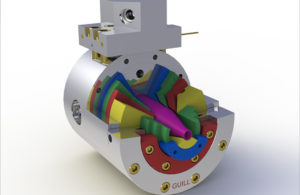As the medical industry migrates more to multi-layer, multi-lumen tubing for various uses, the extrusion die design and manufacturing supply chain has likewise evolved. That includes new crosshead designs.
Bill Conley, Guill Tool & Engineering

Here are the basics about what you need to know about creating multi-chambered crossheads:
- The die designer must start with the very latest technology in 3D CAD and a state-of-the-art computer flow simulation program. It’s important to accurately predict the flow mechanics and potential temperature challenges that might impact the sensitive materials and thin wall or multi-layer constructions of today’s medical tubing.
- A finite element analysis program can combine with SolidWorks or other final output to enable custom design of all types of the extrusion tooling products – including crossheads, inlines, spiderless inlines, rotary heads, deflectors, tips, dies, and the die handling apparatus such as clamps, swing gates, flanges and breaker plates. Proper die performance and assembly accuracies are essential.
- A quality rheology lab is also critical in the preparation of multi-layer and multi-lumen tubing dies. The flow characteristics of the disparate materials used can often impact heater placement, temp sensor types and placement, so the extra rheology lab effort will invariably reduce delays in the design process as well as reworks and inline iterations, which can be very costly to the tubing processors.
- When such diework is ready for production, the best machine tools are an absolute necessity, including full wire and small hole sinker EDM, plus true five-axis machining centers to work super alloys and exotic metals to very close tolerances. This level of capital investment is needed to produce diework that will last in the field, with proper maintenance, producing high quality tubing on a consistent basis.
- Also notable is the need for the diework to be inspected, disassembled, thoroughly cleaned and reassembled, using die carts and swing gates specifically designed for use with such equipment. Ask your die and crosshead manufacturers for suggestions and maintenance manuals to ensure they can support such high-precision equipment in your plant.
Guill Tool is a world leader in complex diework, providing medical device industry extrusion tooling that can produce medical micro-tubing measuring 0.005 in. in diameter with consistency, as well as complex multi-layer and multi-lumen tubing.
Bill Conley is sales manager at Guill Tool & Engineering (West Warwick, R.I.).
The opinions expressed in this blog post are the author’s only and do not necessarily reflect those of Medical Design and Outsourcing or its employees.

